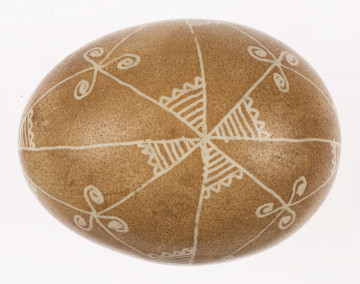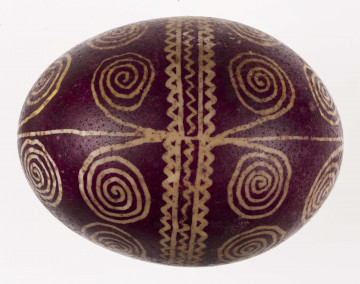
Easter egg
1901 — 1920
National Museum in Lublin
Part of the collection: Folk Art of the Lublin Region (17th–1st half of the 20th c.)
An Easter egg is an attribute of Easter. The egg was a symbol of life, fertility, love and strength, and the symbolism of ornaments written on it played an important magical role. In the Lublin region, eggs were most often decorated using the batik technique, which involved writing on a pattern with melted wax, using a tin made in the form of a funnel set on a stick.
According to the type of ornamentation, Easter eggs from Lublin can be divided into two main groups: northern, where single-coloured pattern with straight lines prevails, and southern, with multi-coloured and numerous volute ornaments; in the central part of Lublin region the influences of the groups intermingled and there were multi-coloured ornaments with straight lines. In the ornamentally rich southern group, depending on the area where the colours and motifs were applied, the following subgroups were distinguished: Biłgorajska, Zamojska, Tomaszowska and Hrubieszowska. The Biłgoraj type was characterised by the fact that the dark red, amaranth or onion stock background harmonised with the white, yellow and green patterns. Characteristic patterns were based on the swastika motif, the trichrome (see E/1082/ML) or the tree of life in the form of a twig of fir or pine (see E/1038/ML).
The swastika, resembling crossed lightning bolts, combined the symbolism of the cross and the circle. It was found in almost all cultures. The name (svastika) comes from Sanskrit and means 'bringer of good luck'. It can have arms bent to the right or to the left. The right-handed form was most often associated with solar cults (in Poland sometimes called swarga, swarzyca, swarożyca, from the god Swarog) and fertility goddesses. The swastika with arms pointing to the left (sauvastika) is a sign of night, darkness, misfortune and magic. On Easter eggs from the Lublin region, the swastika is a symbol of religious worship connected with the sign of the cross (it was often intertwined with its arms). It is also a symbol of lightning, a phenomenon occurring during a spring storm, when the ground turns green after the first rain. Placed on an Easter egg, it expressed a request for blessings and fertility for crops, flocks and people.
In the ethnographic collection of the National Museum in Lublin, there are around 2500 Easter eggs made by artists from the Lublin region. Most of them were made in the years 1950-1980, while a significant number (around 500), unfortunately of unknown authorship, date from the early 20th century.
Author / creator
Dimensions
cały obiekt: height: 5,5 cm
Object type
Easter egg
Technique
batik
Material
wax, egg, plant-based pigment,
Creation time / dating
Creation / finding place
Owner
The National Museum in Lublin
Identification number
Location / status

1901 — 1920
National Museum in Lublin

1901 — 1920
National Museum in Lublin

1901 — 1920
National Museum in Lublin
DISCOVER this TOPIC
Museum of King Jan III's Palace at Wilanów
DISCOVER this PATH
Educational path